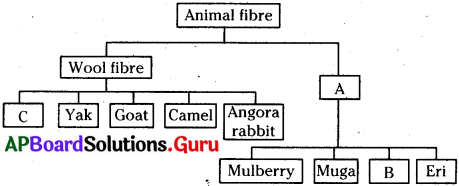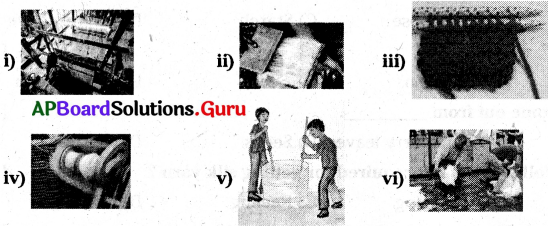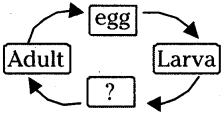Practice the AP 7th Class Science Bits with Answers Chapter 11 Fibres and Fabrics on a regular basis so that you can attempt exams with utmost confidence.
AP 7th Class Science Bits Chapter 11 Fibres and Fabrics with Answers
I. Multiple Choice Questions
Choose the correct answer and write its letters in the brackets.
1. Wool and silk fabrics are derived from
A) plants
B) animals
C) chemical
D) plants and animals
Answer:
B) animals
2. Which of the following is the common vafriety reared for meat and wool in Andhra Pradesh and Telangana and Karnataka?
A) Marino
B) Deccani
C) Angora
D) Cashmere
Answer:
B) Deccani
3. Which is the main source of wool production in Andhra Pradesh?
A) Sheep
B) Goat
C) Camel
D) Rabbit
Answer:
A) Sheep
4. Which gives luxurious wool in India?
A) Marino
B) Deccani
C) Angora
D) Cashmere
Answer:
D) Cashmere
![]()
5. Which is used to make wool?
A) Long hair
B) Outer long hair
C) Fleece
D) All of the above
Answer:
C) Fleece
6. How many stages are there in the process involved in manufacturing of woolen threads?
A) 4 stages
B) 5 stages
C) 6 stages
D) 8 stages
Answer:
C) 6 stages
7. Removing fleece of animal along with the outer thin layer of skin is called
A) Shearing
B) Scouring
C) Carding
D) Combing
Answer:
A) Shearing
8. The process of wrapping the fleece between the two surfaces to make the fibre into a fluffy roll is called ……………….
A) Shearing
B) Scouring
C) Carding
D) Combing
Answer:
C) Carding
9. Process of winding together the fibres to form a yarn is called ………………
A) Dyeing
B) Sorting
C) Carding
D) Spinning
Answer:
D) Spinning
10. Which stages is important of silkmoth for obtaining silk?
A) Egg
B) Larva
C) Pupa
D) Imago
Answer:
B) Larva
11. These are called silk worms.
A) Silk moths
B) Caterpillars
C) Imagoes
D) Pupas
Answer:
B) Caterpillars
12. Larva undergo changes and turns into an adult moth after
A) 10 days
B) 30 – 35 days
C) 10 – 12 days
D) 15 – 20 days
Answer:
C) 10 – 12 days
![]()
13. The place of Andhra Pradesh in the production of silk in the country is
A) First
B) Second
C) Third
D) Tifth
Answer:
B) Second
14. How much yarn can be yield by one cocoon?
A) 100 – 500 meters
B) 500 – 1000 meters
C) 500 – 1500 meters
D) 500 – 2000 meters
Answer:
C) 500 – 1500 meters
15. Which of the following is not a silk city in India?
A) Ramanagara
B) Surat
C) Pochampalli
D) Dharmagiri
Answer:
D) Dharmagiri
→ Look at the following flow chart and answer the questions 16 to 18.

16. Which of the following correctly represents A,B and C respectively?
A) A – Cotton fibre, B – Silk worm, C – Woolly dog
B) A – Jute fibre, B – Cocoon, C – Silk moth
C) A – Silk fibre, B – Tasar, C – Sheep
D) A – Synthetic fibre, B – Khadi, C – Sheep
Answer:
C) A – Silk fibre, B – Tasar, C – Sheep
17. Which of the following is not an application of ‘A’?
A) Clothing
B) Interior decoration
C) Painting
D) Construction
Answer:
D) Construction
18. Which of the following is related to ‘C’?
A) Angora
B) Marino
C) Mohair
D) Cashmere
Answer:
B) Marino
19. Assertion (A) : Scouring is the process of washing sheared fleece in hot water, detergent and alkali in tank
Reason (R) : Scouring removes dirt, grass and grease
A) Both A and R are true and R is the correct explanation of A.
B) Both A and R are true but R is not the correct explanation of A.
C) A is true but R is false.
D) A is false but R is true.
Answer:
A) Both A and R are true and R is the correct explanation of A.
20. Look at the figures given below. These figures show different steps in the production of wool A number from (I) to (vi) is written in each block. Find the correct order of figures.

A) (vi), (ii), (iv), (v), (iii), (i)
B) (vi), (v), (ii), (iv), (iii), (i)
C) (v), (vi), (iii), (ii), (iv), (i)
D) (vi), (iii), (ii), (iv), (i), (v)
Answer:
B) (vi), (v), (ii), (iv), (iii), (i)
21. A female moth lays around …………… of eggs.
A) tens
B) hundreds
C) thousands
D) lakhs
Answer:
B) hundreds
22. The cocoons have to be stiffled to kill …………… inside.
A) Eggs
B) Larva
C) Pupa
D) The worm
Answer:
B) Larva
23. Food for silk worms.
A) Mulberry leaves
B) Mango leaves
C) Coconut leaves
D) Jasmine leaves
Answer:
A) Mulberry leaves
![]()
24. The hair of animals collectively called
A) Fur
B) Skin
C) Fibre
D) None
Answer:
A) Fur
25. Fleece of sheep is removed from its body during …………… season.
A) Winter
B) Summer
C) Rainy
D) Spring
Answer:
D) Spring
26. After washing, …………… is passed over the wool to make it softer.
A) Steam
B) Grease
C) Cool air
D) Hot air
Answer:
C) Cool air
27. Silk is mainly
A) Carbohydrate
B) Worms
C) Protein
D) Cocoon
Answer:
C) Protein
28. The capsule like structure formed is known as ……………
A) Embryo
B) Larvae
C) Seeds
D) Cocoon
Answer:
D) Cocoon
29. Moths are also called ……………
A) Bombyx mori
B) Insects
C) Butterfly
D) Honey bee
Answer:
A) Bombyx mori
30. ………….. district is a silk city of Andhra Pradesh.
A) Guntur
B) Anantapuram
C) Kurnool
D) Krishna
Answer:
B) Anantapuram
31. Caterpillars feed bv leaves.
A) Grass
B) Leaves
C) Cocoon
D) Mulberry leaves
Answer:
D) Mulberry leaves
32. Chandrikalu means …………… .
A) Cane frames
B) Glass tubs
C) Cocoons
D) Mulberry huts
Answer:
A) Cane frames
33. Pupa stops eating after
A) 25 – 30 days
B) 30 – 35 days
C) 40 days
D) 10-12 days
Answer:
B) 30 – 35 days
34. Caterpillar secretes …………… substance.
A) Fibre
B) Cellulose
C) Starch
D) All the above
Answer:
A) Fibre
35. “Pattu kayalu” means
A) Silk worm
B) Cocoon
C) Seeds
D) Chandrikalu
Answer:
B) Cocoon
![]()
36. Adult moths come out from ……………
A) Eggs
B) Mulberry leaves
C) Seeds
D) Cocoon
Answer:
D) Cocoon
37. Which of the following is not required for getting silk yarn?
A) Weaving
B) Spinning
C) Reeling
D) Knitting
Answer:
C) Reeling
38. Special machines like reelers and twisters are used in ……………
A) Reeling
B) Spinning
C) Knitting
D) Weaving
Answer:
A) Reeling
39. Good quality of wool is given by ……………
A) Angora goat
B) Merino sheep
C) Lama
D) Camels
Answer:
B) Merino sheep
40. Rough and coarse hair is produced by
A) Goat
B) Sheep
C) Camel
D) Rabbit
Answer:
C) Camel
41. Scouring means removing of
A) Dust
B) Grease
C) Dirt
D) All of these
Answer:
D) All of these
42. The correct order is
1) Egg 2) Pupa 3) Adult 4) larva
A) 1, 2, 4, 3
B) 1, 4, 2, 3
C) 1, 3, 2, 4
D) 1, 4, 3, 2
Answer:
B) 1, 4, 2, 3
43. ‘Grinages’ are
A) Seed centers
B) Larva centers
C) Adult centers
D) Silk centers
Answer:
A) Seed centers
44. ‘Bombyx mori’ is a
A) Honey bee
B) Warsp
C) Housefly
D) Silk moth
Answer:
D) Silk moth
45. Killing of the silk moth larva’s is called
A) Reeling
B) Yarn
C) Stiffling
D) Silk
Answer:
C) Stiffling
46. The stiffling process takes place at
A) Reeling centers
B) Grinages
C) Chandrikalu
D) Horsely Hills
Answer:
A) Reeling centers
47.  The process in the picture is
The process in the picture is
A) Stiffling
B) Reeling
C) Warping
D) Feeding
Answer:
A) Stiffling
48.  The equipment show in the figure is
The equipment show in the figure is
A) Cacoon
B) Chandrikalu
C) Reeling
D) Woven
Answer:
B) Chandrikalu
49. Fill the blank in the life cycle of silk moth

A) Pupa
B) Laren
C) Silk moth
D) Housefly
Answer:
A) Pupa
50. The country that used the silk for first time
A) India
B) China
C) Japan
D) America
Answer:
B) China
![]()
51. 1) Dyeing 2) Sorting 3) Scouring 4) Shearing
The correct order is
A) 4, 3, 2, 1
B) 2, 3, 4, 1
C) 4, 3, 1, 2
D) 3, 4, 2, 1
Answer:
B) 2, 3, 4, 1
52. Removing the colour of wool is
A) Bleaching
B) Sorting
C) Spinning
D) Scouring
Answer:
A) Bleaching
53. Making threads of yarn is
A) Spinning
B) Carding
C) Dyeing
D) Sorting
Answer:
A) Spinning
54. Which city is called silk city in our State?
A) Venkatagiri
B) Dharmavaram
C) Madanapalli
D) Hartuman Junction
Answer:
B) Dharmavaram
55. The first stage in making of woollen clothes.
A) Scouring
B) Sorting
C) Shearing
D) Bleaching
Answer:
C) Shearing
56. Fill the blank in the flow chart with the given answer.

A) Stiffling
B) Moths
C) Reeling
D) Chilakalu
Answer:
A) Stiffling
57. Material present in silk thread
A) Protein
B) Fat
C) Carbohydrate
D) Cellulose
Answer:
A) Protein
58. If you went to silk showroom to know the quality of silk, what type of exact question do you ask?
A) How do you decide the cost?
B) Do they have good durability?
C) How silk is prepared with?
D) How many types of silks are there?
Answer:
B) Do they have good durability?
59. In summer season what type of clothes do you wear?
A) Cotton, light colour
B) Woolen, Silk
C) Cotton, dark colour
D) Silk, Woolen
Answer:
A) Cotton, light colour
![]()
60. Animal fibre : protein :: plant fibre : ………….
A) Fat
B) Protein
C) Carbohydrate
D) Mineral
Answer:
C) Carbohydrate
61. Which of the following shows the correct sequence of processes in making woolen fabric?
A) Shearing – scouring – sorting – dyeing – combing – spinning
B) Scouring – spinning – combing – shearing – sorting – dyeing
C) Sorting – scouring – shearing – combing – spinning – dyeing
D) Shearing – dying – combing – spinning – scouring – sorting
Answer:
A) Shearing – scouring – sorting – dyeing – combing – spinning
62. Name the stages of silkworm weavers buy from sericulture industury.
A) Larva
B) Pupa
C) Eggs
D) Moth
Answer:
B) Pupa
63. Identify the process that helps to store the cocoons for a long time.
A) Boiling
B) Stiffling
C) Reeling
D) Weaving
Answer:
A) Boiling
64. The sericulture units present in Guntur district are at
A) Pedakakani
B) Bollapalli
C) Tadikonda
D) All the above
Answer:
D) All the above
65. Antheraea mylitta is a
A) Wild silk moth
B) Goat
C) Sheep
D) Camel
Answer:
A) Wild silk moth
66. Which of the following is the quality of animal fibres?
A) More water absorbants
B) Protein based
C) Burns slowly but not continuously
D) All the above
Answer:
D) All the above
67. Acrylic is used to make
A) Sweaters
B) Shawls
C) Blankets
D) AIL the above
Answer:
D) AIL the above
![]()
68. Which of the following is not made from chemicals?
A) Polyester
B) Terelene
C) Rayon
D) None
Answer:
C) Rayon
69. Fabrics made from this fibres does not get wrinkles easily …….
A) Acrylic
B) Rayon
C) Polyester
D) Nylon
Answer:
C) Polyester
70. Ropes for parachute are made from
A) Acrylic
B) Rayon
C) Nylon
D) Polyester
Answer:
C) Nylon
71. Which fabric is used to make sarees?
A) Nylon
B) Polyester
C) Terelene
D) Acrylic
Answer:
C) Terelene
II. Fill in the blanks
1. ……………….. goat is famous for wool.
2. ……………….. is the goat variety which give luxurious wool in India.
3. ……………….. animal shed their hair every year which has similar properties to wool.
4. Camels are reared in ……………….. states.
5. Camels are reared for ……………….. .
6. Yaks are found in ……………….. of India.
7. ……………….. breed of rabbit’s fur is used to make colourful coats.
8. The first step in the processing of fibres into wool is ……………….. .
9. Shearing is generally done during ……………….. season.
10. ……………….. is used for scouring of wool.
11. We get colourful woolen clothes by the process of ……………….. .
12. The process of wrapping the fleece between the two surfaces to make the fibres into a fluffy roll is called ……………….. .
13. ……………….. village is famous for quality woolen carpets in Kurnool district.
14. Cocoons are also known as ……………….. .
15. In four stages of silk moth ……………….. stage is important for obtaining silk.
16. Silk worms prefer to eat ……………….. .
17. The larvae are kept in specialized cane structures called ……………….. .
18. The process of killing larvae inside cocoon by putting them in steam is known as ……………….. .
19. The process of extracting threads from cocoon is called ……………….. .
20. The scientific name of silkworm is ……………….. .
21. W.H.O refers to ……………….. .
22. Animal fibres are dissolved in ……………….. .
23. ……………….. chemical is present in toilet cleaners, disinfectants and cloth whiteness.
24. ……………….. are kept in the clothes to protect them from insects.
25. ……………….. protein is present ip wool fibres.
26. ……………….. protein is present in silk fibres.
27. Rearing of silk worms for getting silk is known as ……………….. .
28. Masks made of ……………….. avoid skin allergies and itching caused by longtime usage.
29. WHO recommends a ……………….. layered cotton fabric mask to protect ourselves from ……………….. .
30. We buy woolen clothes specially for ……………….. .
Answer:
1. Angora
2. Kashmere
3. Camel
4. Rajasthan, Haryana and Gujarath
5. milk, meat and wool
6. Ladhak
7. Angora
8. shearing
9. Spring
10. detergent
11. dyeing
12. Carding
13. Parla
14. Pattukaayalu
15. Larva
16. Mulberry leaves
17. Chandrikalu
18. stiffling
19. Reeling
20. Bombyx mori
21. World Health Organization
22. Chlorine bleach
23. Sodium hypochlorite
24. ball of phenopthalene
25. Keratin
26. Fibroin
27. Sericulture
28. natural fabric
29. three, COVID -19
30. winter
III. Match the following.
1. Group-A Group – B 1. Tasar silk 2. Stiffling 3. Reeling 4. Marino 5. Angora a) Wool yielding sheep b) Wool yielding goat c) Wool yeilding camel d) Extracting silk threads e) Killing the larvae by steaming f) Arjuna and Sal trees
Answer:
2. Group – A Group – B 1. Acrylic [ 1 a) Sarees and terelene , 2. Rayon [ ] b) Doesn’t get wrinkless 3. Nylon [ ] c) Ropes for parachute 4. Polyester [ ] d) Artificial silk 5. Terelene [ ] e) Sweaters and shawls f) Rain coats
Answer:
3. Group – A Group – B 1. Rolling [ ] a) Sodium hypochlorite 2. Phenopthalene [ ] b) Wood pulp 3. Synthetic fibre [ ] c) Silk 4. Natural fibres [ 1 d) Acrylic 5. Rayon [ 1 e) Protection of clothes f) Silk sarees
Answer:
4. Group – A Group – B 1. Cashmere [ ] a) South America 2. Marino [ ] b) Jammu and Kashmir 3. Yak [ ] c) Rajasthan 4. Camel [ ] d) Ladhak 5. Lama [ ] e) Australia f) South Africa
Answer:
5. Group – A Group – B 1. Silk city in A.P. [ 1 a) Ramanagara 2. Silk city in T.S. [ ] b) Chanderi 3. Silk city in Karnataka [ ] c) Pochampalli 4. Silk city in Tamil Nadu [ ] d) Surat , 5. Silk city in Madhya Pradesh *. [. ] e) Dharmavaram f) Kanchipuram
Answer: